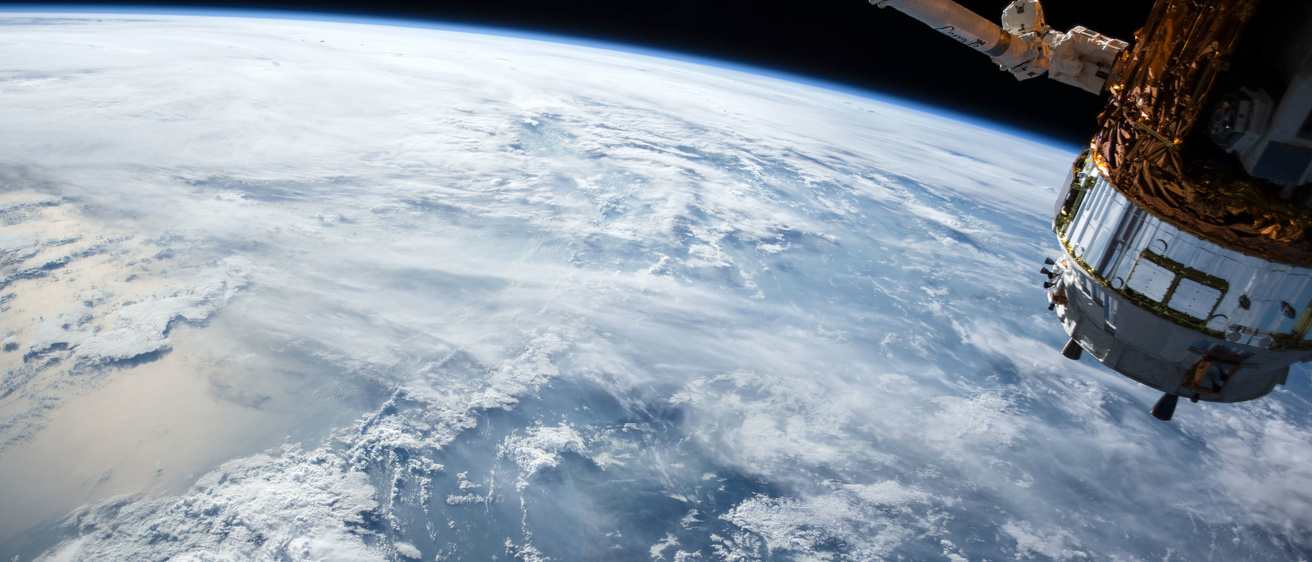Main navigation
Space physics is the study of everything above the Earth’s atmosphere, where the ionosphere and magnetosphere reside, and from the sun, to the solar system and beyond. Plasmas, gases of charged particles, make up over 99% of the solar system such as in the sun’s core and corona, the solar wind, interplanetary space, and the planetary magnetospheres, and so are a natural focus of the discipline. The ionosphere is a gas of charged particles created by the ionization of particles in the atmosphere from UV radiation from the sun. The magnetosphere is a region of space around the Earth containing the Earth’s magnetic field. It is created by currents flowing in the Earth’s outer liquid core, and extends to where it meets the interplanetary magnetic field created by the solar wind (the magnetopause). The solar wind is a flux of charged particles ejected from the solar corona. The magnetosphere contains the Van Allen radiation belts, typically two belts containing high-energy charged particles trapped from the solar wind and the ionosphere. The discovery of these radiation belts in the 1950’s by James Van Allen, a professor who spent his career at the University of Iowa, through Explorer I launched space physics as a discipline. The solar wind interacts with the Earth’s magnetic field, and disturbances can lead to geomagnetic storms that can affect communication and GPS satellites, spacecraft, the power grid, and other technology.
Four advanced courses in the fundamentals of plasma physics and its application in space and astrophysical environments are offered regularly, as well as specialty courses offered periodically on numerical simulations of plasmas, spacecraft instrumentation for plasma measurements, and data analysis methods in plasma physics and space physics. A plasma physics seminar and a space physics and astrophysics seminar are each held weekly during the academic year.
Space physics research at the University of Iowa is world-renowned, and alumni of the program include scientists such as Donald Gurnett (who also spent his career as a professor at UI), whose discoveries include solving how auroras are created and detecting the heliopause (the boundary between our solar system and outer space) with Voyager 1, and James Hansen, a pioneering climatologist and former director of NASA Goddard Institute for Space Studies. In all, researchers at UI have contributed to instrumentation on over one hundred rocket and spacecraft missions.
Current researchers study such topics as the origin of Jupiter's magnetosphere and magnetic field, the solar wind interacting with Mars and moons, near-sun electron properties, charged particle dynamics in the Earth’s magnetosphere, physics of the auroras, physics of magnetic reconnection at the magnetopause, magnetosphere-ionosphere coupling, Alfven waves, and exploring interstellar space. UI researchers continue to build instrumentation that contributes to spacecraft missions, including current and recent missions such as TRACERS, Van Allen Probes, Juno, MMS, SWARM/CASSIOPE, THEMIS-ARTEMIS, Mars Express, Cluster II, Voyagers 1 and 2 and TRICE-2.
13
70+
University of Iowa contributions to space
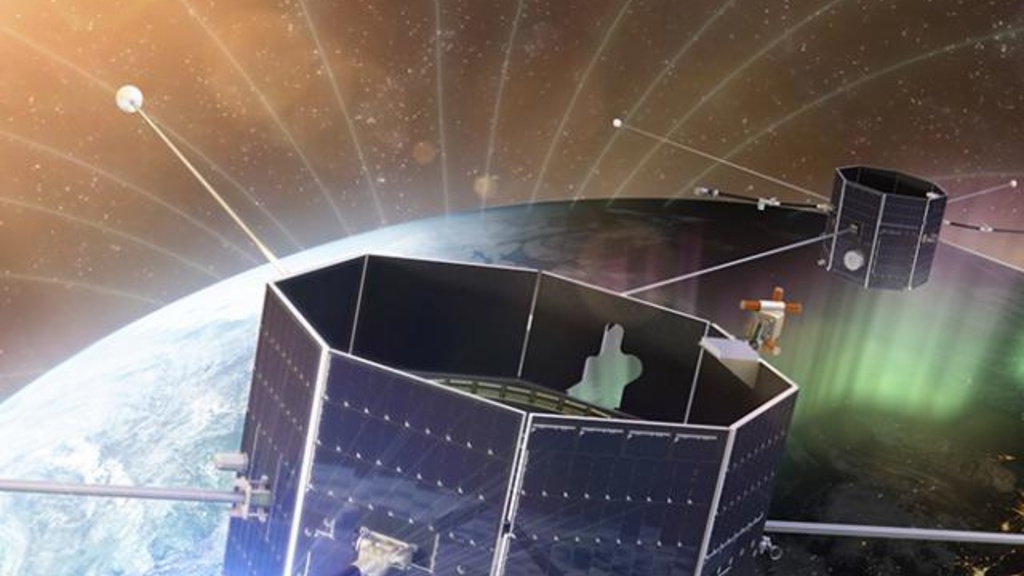
TRACERS
The NASA-funded Tandem Reconnection and Cusp Electrodynamics Reconnaissance Satellites (TRACERS) will study the mysterious, powerful interactions between the magnetic fields of the sun and Earth. TRACERS, consisting of two identical satellites that will orbit Earth in tandem (one following the other), will help answer long-standing questions key to understanding space weather, particularly how the Sun transfers energy, mass, and momentum to near-Earth space. The mission, led by UI Associate Professor David Miles, received $115 million, making it the single largest externally funded research project in institutional history.
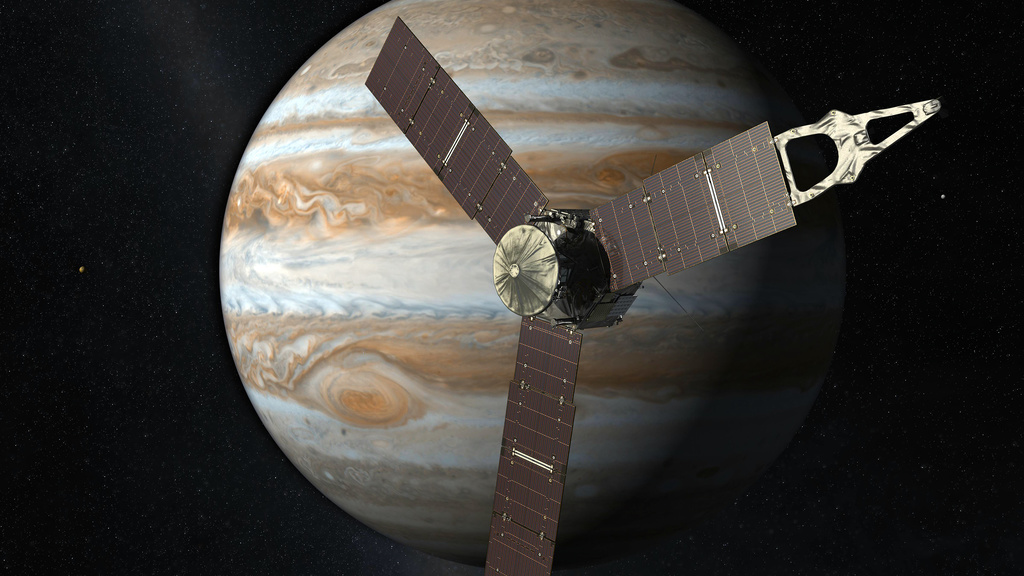
Juno
The Juno mission is conducting an in-depth study of the giant planet Jupiter. Juno is the first mission to use a polar orbit to study Jupiter, allowing it to carry out the first exploration of the polar magnetosphere which hosts the solar system's brightest auroras. The solar-powered spacecraft launched on August 5, 2011, and entered into Jupiter orbit on July 4, 2016, where it is investigating the existence of an ice-rock core, determining the amount of global water and ammonia present in the atmosphere, studying convection and deep wind profiles in the atmosphere, investigating the origin of the Jovian magnetic field, and exploring the polar magnetosphere.
Juno's mission at Jupiter was recently extended, beginning in August 2021. The mission extension provides for Juno to continue orbiting Jupiter until late 2025.
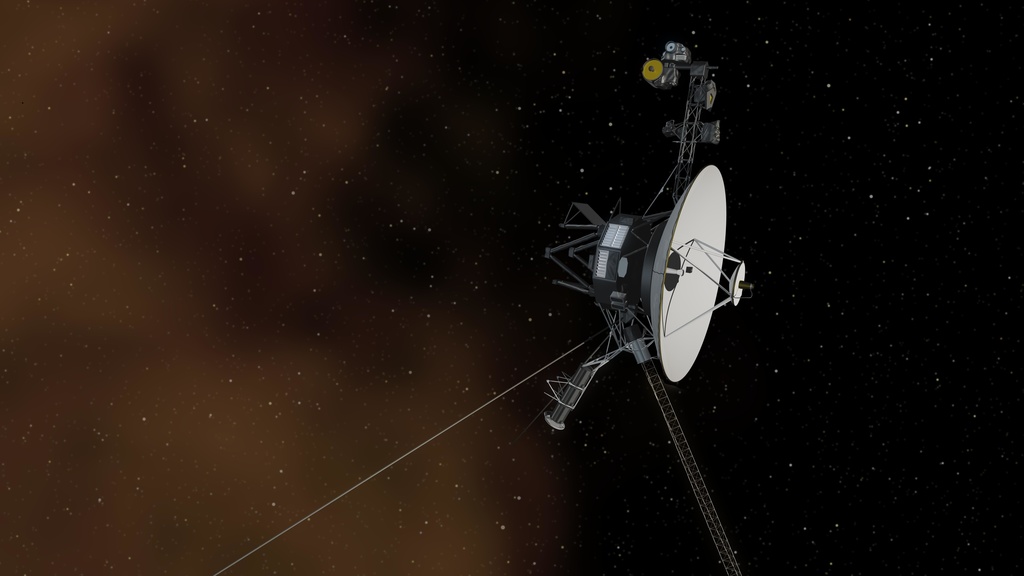
Voyager
The Voyager 1 and 2 spacecraft are exploring where nothing from Earth has flown before – interstellar space. The two spacecraft, launched in 1977 each carrying a University of Iowa designed and built Plasma Wave Instrument, began their journeys by exploring the outer planets of our solar system before entering interstellar space. Data from the Iowa instruments have enabled researchers to make discoveries, including the first observations of plasma waves and low-frequency radio emissions in the magnetospheres of Jupiter, Saturn, Uranus, and Neptune; confirming the presence of lightning in the atmospheres of Jupiter and Neptune; the first measurements of the electron density in the interstellar medium, and the first detection in interstellar space of shocks related to solar activity. Dr. Bill Kurth and Prof. Allison Jaynes are both co-Investigators on the mission. Both spacecraft continue to send scientific information about their surroundings through the Deep Space Network.
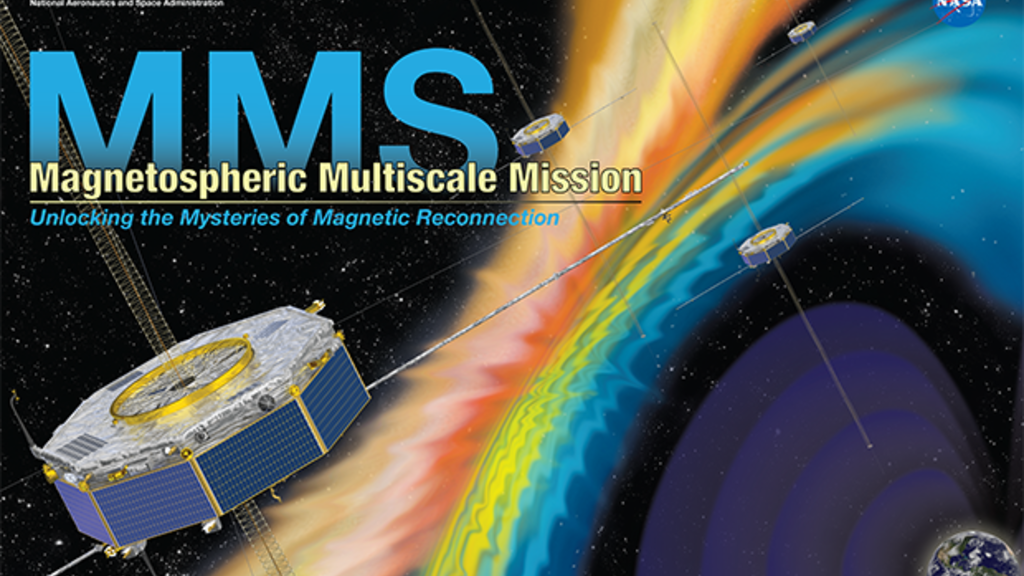
Magnetospheric Multiscale Mission
MMS investigates how the Sun’s and Earth’s magnetic fields connect and disconnect, explosively transferring energy from one to the other in a process that is important at the Sun, other planets, and everywhere in the universe, known as magnetic reconnection. Reconnection limits the performance of fusion reactors and is the final governor of geospace weather that affects modern technological systems such as telecommunications networks, GPS navigation, and electrical power grids. Four identically instrumented spacecraft measure plasmas, fields, and particles in a near-equatorial orbit that will frequently encounter reconnection in action. Assistant Research Scientist Scott Bounds was on the Electron Drift Instrument (EDI) team for the mission. Prof. Allison Jaynes is an instrument team member for the Energetic Particle Detector suite.
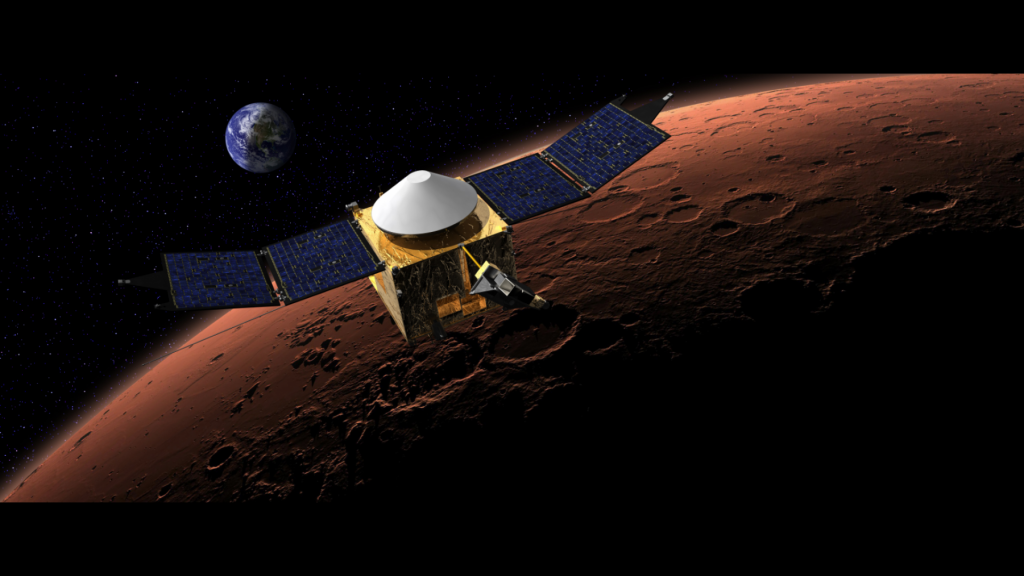
MAVEN
The Mars Atmosphere and Volatile EvolutioN (MAVEN) mission, which launched from Cape Canaveral Air Force Station on November 18, 2013, is the first mission devoted to understanding the Martian upper atmosphere. The goal of MAVEN is to determine the role that loss of atmospheric gas to space played in changing the Martian climate through time. Where did the atmosphere—and the water—go? MAVEN will determine how much of the Martian atmosphere has been lost over time by measuring the current rate of escape to space and gathering enough information about the relevant processes to allow extrapolation backward in time. Prof. Jasper Halekas is the instrument lead for the Solar Wind Ion Analyzer (SWIA) on MAVEN, which measures the solar wind and magnetosheath ion density and velocity.
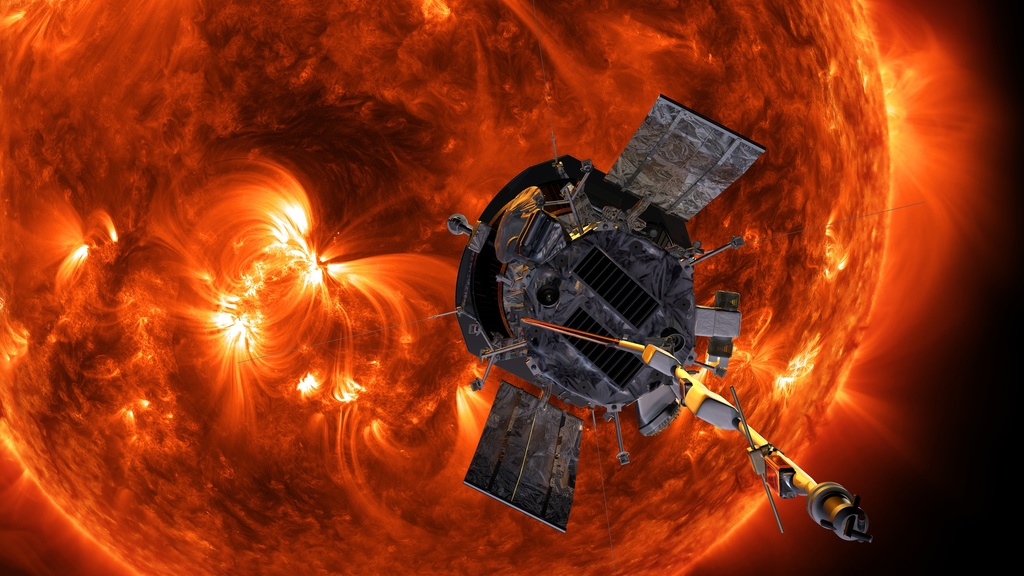
Parker Solar Probe
Parker Solar Probe will swoop to within 4 million miles of the Sun's surface, facing heat and radiation like no spacecraft before it. Launched on Aug. 12, 2018, Parker Solar Probe will provide new data on solar activity and make critical contributions to our ability to forecast major space-weather events that impact life on Earth. Prof. Jasper Halekas is the instrument scientist for the Solar Probe Analyzer (SPAN) electron sensors for the SWEAP suite on the probe.
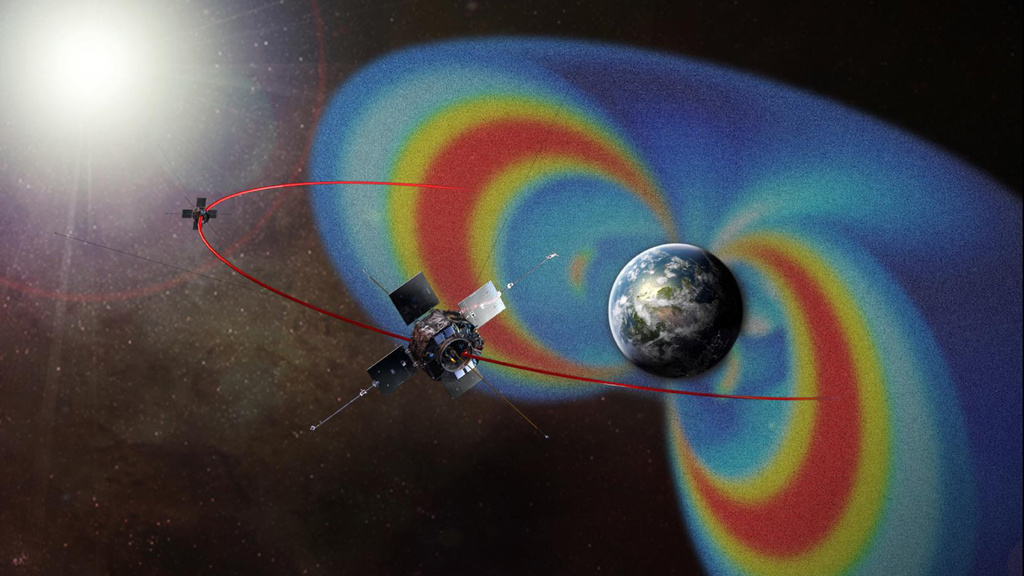
Van Allen Probes
The Van Allen Probes (2012-2019), the second mission of NASA's Living With a Star program, explored fundamental processes that operate throughout the solar system, in particular those that generate hazardous space weather effects near the Earth and phenomena that could affect solar system exploration. A University of Iowa team led by the late Prof. Craig Kletzing developed the EMFISIS instrument suite and Waves instrument suites Van Allen Probes mission. Prof. Allison Jaynes was a Co-Investigator on the Relativistic Electron Proton Telescope (REPT) instrument, part of the Energetic Particle, Composition, and Thermal Plasma (ECT) Suite.
Additional contributions
Spaceflight Instruments
Spaceflight instruments developed at the University of Iowa Department of Physics and Astronomy.
View Instruments in Space Poster
| Spacecraft | Launch Date (UT) |
|---|---|
| Explorer 1 | 1958 Feb. 1 |
| Explorer 2 (launch failure) | 1958 Mar. 5 |
| Explorer 3 | 1958 Mar. 26 |
| Explorer 4 | 1958 July 26 |
| Explorer 5 (launch failure) | 1958 Aug. 24 |
| Pioneer 1 | 1958 Oct. 11 |
| Pioneer 2 | 1958 Nov. 8 |
| Pioneer 3 | 1958 Dec. 6 |
| Pioneer 4 | 1959 Mar. 3 |
| Explorer 7 (launch failure) | 1959 Jul. 16 |
| Explorer 7 | 1959 Oct. 13 |
| S-46 (launch failure) | 1960 Mar. 23 |
| Injun 1 | 1961 June 29 |
| Explorer 12 | 1961 Aug. 16 |
| Ranger (failed to reach orbit) | 1961 Aug. 23 |
| TRAAC | 1961 Nov. 15 |
| Ranger 2 (failed to reach orbit) | 1961 Nov. 18 |
| Injun 2 (launch failure) | 1962 Jan. 24 |
| Discoverer 38 | 1962 Feb. 27 |
| Mariner 1 (launch failure) | 1962 Jul. 22 |
| Mariner 2 | 1962 Aug. 27 |
| Explorer 14 | 1962 Oct. 2 |
| Explorer 15 | 1962 Oct. 27 |
| Injun 3 | 1962 Dec. 12 |
| Relay 1 | 1962 Dec. 13 |
| P-11 | 1964 Aug. 14 |
| OGO 1 | 1964 Sept. 5 |
| Mariner 3 (shroud failure) | 1964 Nov. 5 |
| Injun 4 | 1964 Nov. 21 |
| Mariner 4 | 1964 Nov. 28 |
| OGO 2 | 1965 Oct. 14 |
| OGO 3 | 1966 June 7 |
| Explorer 33 (IMP-D) | 1966 July 1 |
| Explorer 34 (IMP-4) | 1967 May 24 |
| Mariner 5 | 1967 June 14 |
| Explorer 35 (IMP-E) | 1967 July 19 |
| OGO 4 | 1967 July 28 |
| OGO 5 | 1968 Mar. 4 |
| Injun 5 | 1968 Aug. 8 |
| Explorer 41 (IMP-5) | 1969 June 21 |
| Explorer 43 (IMP- 6) | 1971 Mar. 13 |
| Explorer 45 (SSS) | 1971 Nov. 16 |
| UK 4 (Ariel-4) | 1971 Dec. 11 |
| Pioneer 10 | 1972 Mar. 3 |
| Explorer 47 (IMP-7) | 1972 Sept. 23 |
| Pioneer 11 | 1973 Apr. 6 |
| Explorer 50 (IMP-8) | 1973 Oct. 26 |
| Hawkeye 1 | 1974 June 3 |
| Helios 1 | 1974 Dec. 10 |
| Helios 2 | 1976 Jan. 15 |
| Voyager 2 * | 1977 Aug. 20 |
| Voyager 1 * | 1977 Sept. 5 |
| International Sun-Earth Explorer 1 | 1977 Oct. 22 |
| International Sun-Earth Explorer 2 | 1977 Oct. 22 |
| International Sun-Earth Explorer 3 | 1978 Aug. 12 |
| Firewheel (launch failure) | 1980 May 25 |
| Dynamic Explorer 1 | 1981 Aug. 3 |
| Plasma Diagnostics Package (shuttle Columbia) | 1982 Mar. 22 |
| AMPTE / IRM | 1984 Aug. 16 |
| Plasma Diagnostics Package (shuttle Challenger) | 1985 Jul. 29 |
| Galileo (terminated by plunging spacecraft into Jupiter, 9/2003) | 1989 Oct. 18 |
| CRRES | 1990 July 25 |
| Geotail | 1992 July 24 |
| Wind * | 1994 Nov. 1 |
| Polar | 1996 Feb. 24 |
| Cluster I (4 spacecraft) (launch failure) | 1996 June 4 |
| Cassini (terminated by plunging spacecraft into Saturn, 9/2018) | 1997 Oct. 15 |
| Cluster Salsa (FM6) | 2000 July 16 |
| Cluster Samba (FM7) | 2000 July 16 |
| Cluster Tango (FM8) | 2000 Aug. 9 |
| Cluster Rumba (FM5) | 2000 Aug. 9 |
| Mars Express * | 2003 June 2 |
| Juno * | 2011 Aug. 5 |
| Van Allen Probe A (1 of 2 spacecraft) | 2012 Aug.30 |
| Van Allen Probe B (1 of 2 spacecraft) | 2012 Aug.30 |
| Magnetospheric Multiscale Mission 1 (1 of 4 spacecraft) * | 2015 Mar.12 |
| Magnetospheric Multiscale Mission 2 (1 of 4 spacecraft) * | 2015 Mar.12 |
| Magnetospheric Multiscale Mission 3 (1 of 4 spacecraft) * | 2015 Mar.12 |
| Magnetospheric Multiscale Mission 4 (1 of 4 spacecraft) * | 2015 Mar.12 |
| HERCI CubeSat/Fox-1D | 2018 Jan. 12 |
| HaloSat Cube Satellite | 2018 May 21 |
| TRACERS SV 1 | 2025 July 23 |
| TRACERS SV 2 | 2025 July 23 |
*Spacecraft carrying currently operating Iowa instruments
| Rockets | Launch Date |
|---|---|
| Rockoons (109 launches) payloads and casings | 1951-1957 |
| Javelin 8:45 experiment | 1967 Sept. 21 |
| Javelin 8:46 experiment | 1968 May 25 |
| Spear 1 pressure gauge | 1987 Dec. 13 |
| Spear 3 pressure gauge | 1993 Mar. 15 |
| Rocket Auroral Correlator Experiment (RACE) | 2002 Feb. 6 |
| High Bandwidth Auroral Rocket (HiBAR) | 2003 Jan. 28 |
| Correlations of High Frequencies & Auroral Roar Mission (CHARM) | 2007 Feb. 28 |
| Twin Rockets to Investigate Cusp Electrodynamics (TRICE) Mission 1/A | 2007 Dec. 10 |
| Twin Rockets to Investigate Cusp Electrodynamics (TRICE) Mission 1/B | 2007 Dec. 10 |
| Auroral Current and Electrodynamic Structure (ACES) Rocket 1/A | 2009 Jan. 29 |
| Auroral Current and Electrodynamic Structure (ACES) Rocket 1/B | 2009 Jan. 29 |
| Black Brant IX Sounding Rocket/CyXESS Mission | 2009 Nov. 13 |
| Correlations of High Frequencies & Auroral Roar Mission (CHARM 2) | 2010 Feb. 17 |
| Off-Plane Grating Rocket for Extended Source Spectroscopy 1 (OGRESS 1) | 2015 May 2 |
| Twin Rockets to Investigate Cusp Electrodynamics 2 (TRICE-2) Mission 2/A | 2018 Dec. 8 |
| Twin Rockets to Investigate Cusp Electrodynamics 2 (TRICE-2) Mission 2/B | 2018 Dec. 8 |
| Cusp Alfven and Plasma Electrodynamics Rocket 2 (CAPER 2) | 2019 Jan. 4 |
| Investigation of Cusp Irregularities (ICI-5) | 2019 Nov. 26 |
| VLF Trans-Ionospheric Propagation Exp. Rocket (VIPER) Search Coils | 2021 May 26 |
| Loss through Auroral Microburst Pulsations (LAMP) instrument | 2022 Mar. 5 |
| Auroral Current & Electrodynamic Structure Rocket 2 (ACES) Rocket 2/A | 2022 Nov. 20 |
| Auroral Current & Electrodynamic Structure (ACES) Rocket 2/B | 2022 Nov. 20 |
| COUSIN - Study of small-scale auroral region energy deposition | 2026 TBD |
| Observing Cusp High-Altitude Reconnection & Electrodynamics (OCHRE) | 2026 TBD |
| Investigation of Cusp Irregularities 5bis (ICI-5bis) Pathfinder | TBD |
Major Accomplishments in Space Physics Research
These are based on data collected by University of Iowa-developed instruments.
| Explorer 1 | February 1, 1958 | Designed and developed the science instrument on the first successful U.S. satellite, which lead to the discovery of Earth's radiation belts |
| Explorer 3 | March 1958 | Designed and developed the first tape recorder for spaceflight |
| Injun 1 | June 29, 1961 | First university to design, assemble, operate, and track a successful satellite |
| Mariner 2 | August 1962 | Instrumentation on the first flight to another planet (Venus) |
| Mariner 4 | November 1964 | Instrumentation on the first flight to Mars |
| Pioneer 10 | March 1972 | Instrumentation on the first flight to Jupiter |
| Pioneer 11 | April 1973 | Instrumentation on the first flight to Saturn |
| Pioneer 10 | December 1973 | Discovery of radiation belts at Jupiter |
| Voyager 2 | August 1977 | Instrumentation on the first flight to Uranus |
| Voyager 2 | August 1977 | Instrumentation on the first flight to Neptune |
| Pioneer 10/11 | 1979 | Discovery and first survey of radiation belts of Saturn |
| Voyager 1 | 1979 | Establish the presence of lightning at Jupiter |
| Plasma Diagnostics Package | July 1985 | First satellite released and recovered during a space shuttle mission |
| ISEE 3 | September 1985 | Instrumentation on the first flyby of a comet (Comet Giacobini-Zinner) |
| Galileo | October 1989 | Instrumentation on the first orbiter of Jupiter |
| Galileo | October 1991 | In situ measurements of the asteroid Gaspra |
| Galileo | August 1993 | In situ measurements of the asteroid Ida |
| Galileo | June 1996 | Discovery of the first magnetosphere of a planetary moon (Ganymede) |
| Cassini | October 1997 | Instrumentation on the first orbiter of Saturn |
| Galileo/Cassini | December 2000 | Three scientific instruments on two spacecraft simultaneously collected data at Jupiter |
| Mars Express | 2004 | First subsurface and ionospheric radar measurements at Mars |
| Voyager 2 | August 2007 | First measurements of plasma waves at heliospheric termination shock |
| Cassini | December 2010 | First measurements of lightning from a global storm on Saturn |
| Voyager 1 | Oct./Nov. 2012 | First man-made object to enter interstellar space and make measurements in interstellar medium |
| Mars Express | October 2014 | First measurements during a close comet flyby of Mars (Comet Siding-Spring) |
| Juno | July 2016 | Instrument on the first polar orbiter of Jupiter |
| HaloSat | May 2018 | First astrophysics-focused and competitively selected CubeSat mission funded by NASA's Astrophysics Division |
Spacecraft
Spacecraft designed and built at the University of Iowa.
| Spacecraft | Launch Date |
|---|---|
| S-46 | March 23, 1960 (Launch failure) Launch vehicle: Juno II |
| Iowa 1 (Injun 1) | June 29, 1961 Launch vehicle: Thor/Able Star/Air Force End of flight: March 5, 1963 Mission objective: To study charged particles trapped in Earth's magnetosphere |
| Iowa 2 (Injun 2) | January 24, 1962 (failed to reach orbit) Launch vehicle: Thor/Able Star/Air Force |
| Iowa 3 (Injun 3) | December 12, 1962 Launch vehicle: Thor/Agena End of flight: November 5, 1963 Mission Objective: To study charged particles trapped in Earth's magnetosphere |
| Iowa 4 (Injun 4; aka Explorer 25) | November 21, 1964 Launch vehicle: Scout End of flight: July 20, 1966 |
| Iowa 5 (previously Injun 5; aka Explorer 40) | August 8, 1968 Launch vehicle: Scout End of flight: June 7, 1971 |
| Hawkeye 1 (Explorer 52) | June 3, 1974 Launch vehicle: Scout End of flight: April 28, 1978 |
| Plasma Diagnostics Package | March 22, 1982 Launch vehicle: Columbia space shuttle Mission: STS-3; OSS-1 mission End of flight: March 30, 1982 |
| Plasma Diagnostics Package | July 29, 1985 Launch vehicle: Challenger space shuttle Mission: 51-F; Spacelab 2 End of flight: August 6, 1985 |
Snapshot of University of Iowa space physics research milestones
- Developed the science instrument on the first successful U.S. satellite, Explorer 1
- Discovery of radiation belts at Earth, Jupiter, and Saturn
- Between 1958 and 1998 developed more spaceflight instruments than any other university
- First observations by spacecraft at 7 of the 8 planets in our solar system
- First studies of radio emissions and plasma waves at Uranus and Neptune
- First evidence of lightning at Jupiter
- Discovery of a magnetosphere at Ganymede
- First in situ observations with spacecraft of a comet and an asteroid
- Observations by most-distant spacecraft from Earth
- Developed the first object (a satellite) released and recovered by the space shuttle remote manipulator arm
- Developed the first subsurface radar to explore Mars
- First measurements at the heliospheric termination shock
- First man-made object to enter interstellar space and make measurements of interstellar medium
- First measurements during a close comet flyby of a planet
- First astrophysics-focused and competitively selected CubeSat mission funded by NASA's Astrophysics Division
- Design and fabrication of 7 complete, successfully launched spacecraft
- Developed instrumentation on 70 successfully launched spacecraft (as of 2020)
- In 2023, the University of Iowa had operating science instruments on 13 spacecraft
News

Gayley discusses Martian rock that sold for $5 million at auction

Study discovers electromagnetic waves can make the northern lights glow brighter

UI-Led Pathfinder Project Highlighted in NASA Heliophysics Report

Iowa physicists study how Mars became a cold planet
UI leads NASA project to better understand magnetic activity in space

Jaynes Awarded Grant to Study Impact of Space Precipitation in Upper Atmospheres
Space Physics faculty

Gregory G. Howes, PhD

Casey DeRoo, PhD

Kenneth G. Gayley, PhD

Jasper S. Halekas, PhD

Allison N. Jaynes, Ph.D.

David M. Miles, PhD
Space Physics research staff

Scott Bounds, PhD

Ivar W. Christopher

Danielle Crawford

Jeremy B. Faden

Larry J. Granroth

David Hartley, Ph.D.

George Hospodarsky, Ph.D.

William Kurth, PhD

Daniel McGinnis, PhD
J. Douglas Menietti, PhD

Jolene Pickett

Chris Piker

Kevin Steele

